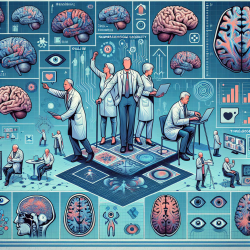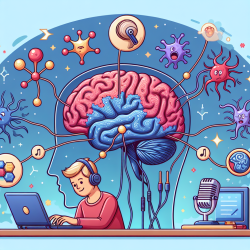Introduction
Frontotemporal dementia (FTD) represents a complex array of syndromes resulting from damage to the frontal and temporal lobes. The recent study, "Neuropathological background of phenotypical variability in frontotemporal dementia," provides a comprehensive review of the relationships between various frontotemporal lobar degeneration (FTLD) pathologies and clinical syndromes. This article aims to translate these findings into practical insights for practitioners, particularly those involved in online therapy services, such as TinyEYE, to enhance their skills and encourage further research.
Understanding the Research
The study categorizes FTLD into three main groups based on the major proteins deposited in the brain: FTLD-tau, FTLD-TDP, and FTLD-FUS. These pathologies correspond to distinct clinical syndromes, such as behavioral variant FTD (bvFTD), progressive non-fluent aphasia, semantic dementia, progressive supranuclear palsy syndrome (PSPS), and corticobasal syndrome (CBS). The research highlights strong associations between certain pathologies and clinical syndromes, such as:
- FTD with motor neuron disease and FTLD-TDP
- Semantic dementia and FTLD-TDP
- PSPS and FTLD-tau
- CBS and FTLD-tau
However, the study also notes that some clinical diagnoses, like bvFTD, do not have a strong relationship with any specific FTLD subtype, presenting a diagnostic challenge.
Implications for Practitioners
Practitioners can leverage these findings to refine diagnostic accuracy and therapeutic approaches. Understanding the neuropathological underpinnings can aid in predicting molecular pathology, which is crucial for tailoring interventions. For instance, recognizing the link between semantic dementia and FTLD-TDP can guide practitioners in focusing on language and comprehension therapies.
Moreover, the study underscores the importance of large clinicopathological studies in understanding the phenotypic variability in FTD, PSPS, and CBS. Practitioners are encouraged to participate in or initiate further research to explore these associations, potentially leading to more precise diagnostic criteria and effective treatment modalities.
Encouraging Further Research
The study calls for continued exploration into the complex relationships between clinical syndromes and molecular pathologies. Practitioners should consider collaborating with researchers to contribute to the growing body of knowledge in this field. By doing so, they can help bridge the gap between research and clinical practice, ultimately enhancing patient outcomes.
Conclusion
The insights from the "Neuropathological background of phenotypical variability in frontotemporal dementia" study offer valuable guidance for practitioners seeking to improve their skills and understanding of FTD. By integrating these findings into practice and engaging in further research, practitioners can contribute to advancing the field of dementia care.
To read the original research paper, please follow this link: Neuropathological background of phenotypical variability in frontotemporal dementia.










